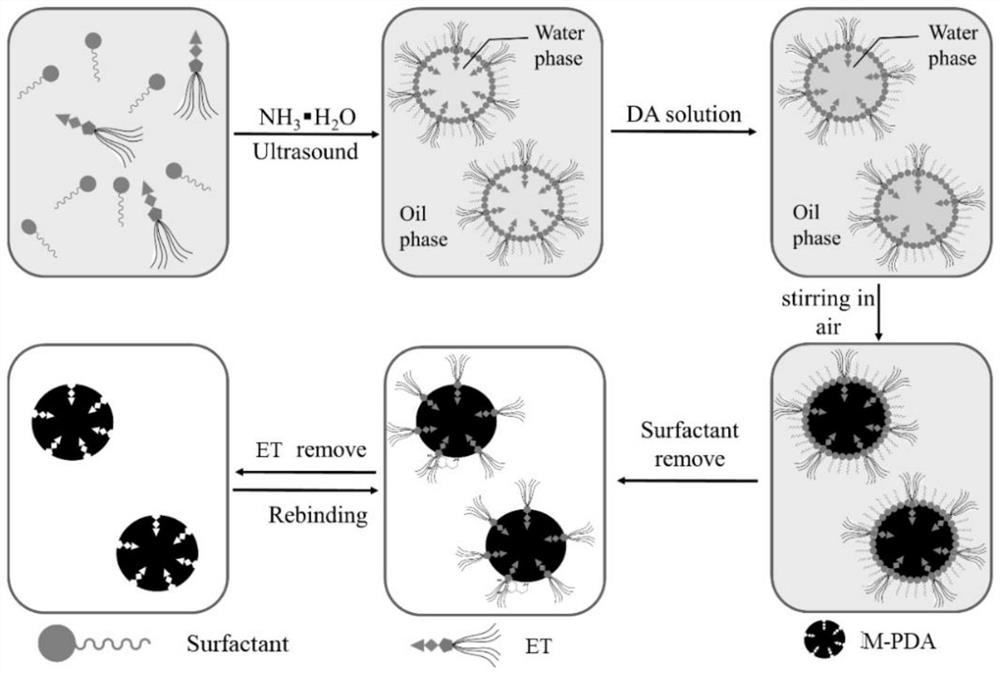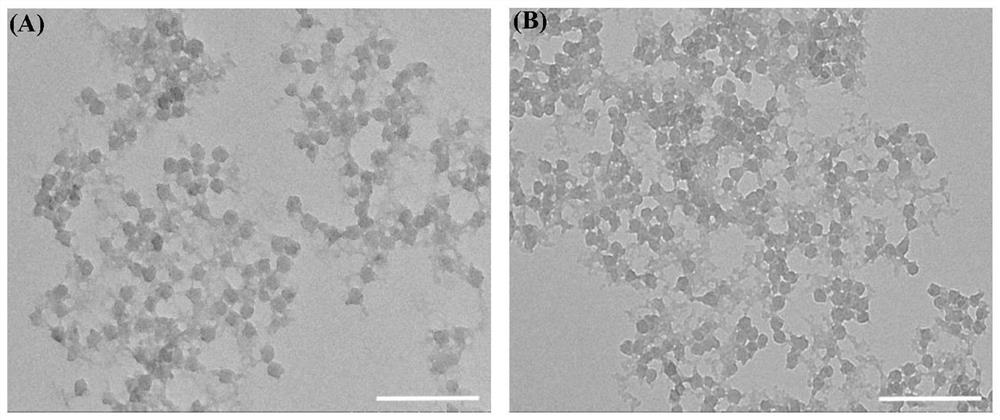Multi-functional photo-thermal nano bactericidal material and preparation and application thereof
A nano-sterilization and photothermal technology, which is applied in the field of antibacterial materials, can solve the problems of inability to kill bacteria and side effects at the same time, and achieve the effects of fast adsorption rate, shortened adsorption time, and large adsorption capacity
- Summary
- Abstract
- Description
- Claims
- Application Information
AI Technical Summary
Problems solved by technology
Method used
Image
Examples
Embodiment 1
[0050] Example 1: Preparation of a multifunctional nano-photothermal sterilizing material M-PDA that can specifically adsorb endotoxin
[0051] figure 1 Preparation of M-PDA nanoparticles flow chart for the present invention. The preparation steps are as follows:
[0052] Step 1: Add endotoxin (ET), surfactant and ammonia water to cyclohexane, stir evenly with magnetic force, and disperse by ultrasonic for 10 minutes;
[0053] Step 2: Add dopamine solution, continue to ultrasonically disperse for 10 minutes to form a microemulsion; magnetically stir the above microemulsion at room temperature for 24 hours, break the emulsion, and collect the precipitate by centrifugation.
[0054] Step 3: wash the precipitate with absolute ethanol and 3% acetic acid aqueous solution respectively, and finally wash 3 times with endotoxin-free depyrogenated pure water to obtain polydopamine nanoparticles (M- PDA)
[0055] As a control, the preparation method of non-imprinted polydopamine nano...
Embodiment 2
[0056] Embodiment 2: Optimization of reaction conditions
[0057] First, the dosage of endotoxin was fixed, the concentration of dopamine DA was adjusted, a series of M-PDA and N-PDA were prepared, and the adsorption effect of each M-PDA and N-PDA on 250 ng / mL endotoxin was compared to determine the optimal DA concentration. Then, maintain the optimal concentration of DA, adjust the amount of endotoxin, prepare a series of M-PDA and N-PDA, and evaluate their adsorption effect on endotoxin.
[0058] Depend on figure 2 A in A shows that when the amount of DA added is between 2.5-10 mg, as the amount of DA increases, the amount of endotoxin adsorbed by M-PDA and the imprinting factor also increase. When the amount of DA was 10 mg, the adsorption amount of endotoxin and the imprinting factor of M-PDA reached the maximum value, and the adsorption amount and the corresponding imprinting factor showed a downward trend when the amount of DA continued to increase. The reason may be t...
Embodiment 3
[0059] Embodiment 3: M-PDA and N-PDA characterization
[0060] Depend on image 3 A in and image 3 In B, it can be seen that the M-PDA and N-PDA nanoparticle morphology prepared in Example 1 are all spherical structures, and the particle size is relatively uniform, which is about 75nm, indicating that DA is in the inverse microemulsion system. Polymerization occurred, and polydopamine nanoparticles were successfully prepared.
[0061] Depend on Figure 4 Visible, FT-IR spectral analysis shows that the M-PDA prepared in embodiment 1 and the N-PDA nanoparticle are all in 3410cm -1 、2929cm -1 、1605cm -1 、1510cm -1 and 1295cm -1 There are obvious characteristic absorption peaks at , corresponding to phenolic hydroxyl, -CH 2 -, benzene ring, amino group and phenolic C-O and other groups. It indicated that DA was successfully polymerized in microemulsion droplets, and polydopamine nanoparticles were generated.
[0062] Table 1 shows the results of dynamic light scattering...
PUM
| Property | Measurement | Unit |
|---|---|---|
| particle diameter | aaaaa | aaaaa |
| surface potential | aaaaa | aaaaa |
Abstract
Description
Claims
Application Information
 Login to View More
Login to View More - R&D
- Intellectual Property
- Life Sciences
- Materials
- Tech Scout
- Unparalleled Data Quality
- Higher Quality Content
- 60% Fewer Hallucinations
Browse by: Latest US Patents, China's latest patents, Technical Efficacy Thesaurus, Application Domain, Technology Topic, Popular Technical Reports.
© 2025 PatSnap. All rights reserved.Legal|Privacy policy|Modern Slavery Act Transparency Statement|Sitemap|About US| Contact US: help@patsnap.com



